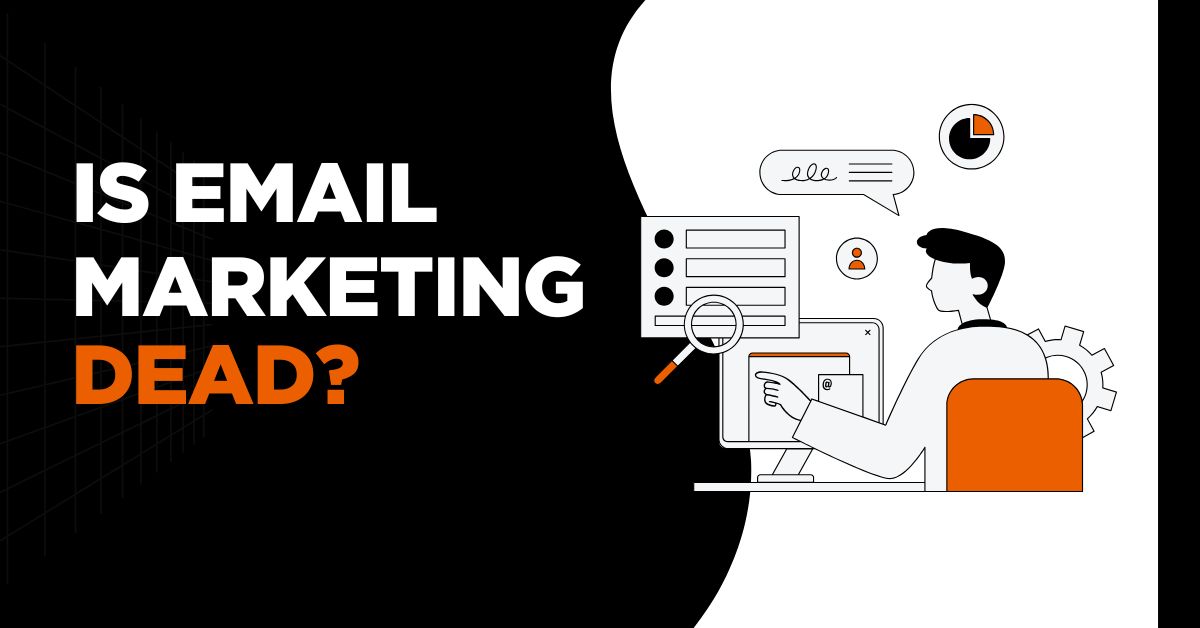Is Email Marketing Dead?
If you’re a business owner, marketer, or even just someone curious about how companies promote their services, you may have heard people saying, “Email marketing is dead.” But is that really true?
We’ll explore this question in simple words. We’ll break down what email marketing is, why some people think it’s dead, and whether it still works in 2025. You’ll learn how it compares to other marketing tools, and why many businesses are still using it today.
Why Do Some People Think Email Marketing Is Dead?
There are a few reasons people think email marketing is no longer useful:
1. Too Many Emails
People get hundreds of emails every week. Many of these are marketing messages. Because of this, they may ignore or delete them without reading.
2. Spam Filters
Some emails never reach the inbox because they get marked as spam. If customers never see your email, it won’t work.
3. Newer Tools Exist
Social media, paid ads, SMS, and chatbots have become popular. These new tools seem more modern and fast.
4. Low Open Rates
If only a small number of people open marketing emails, it may seem like they’re not working.
Why Email Marketing Is Not Dead
Even though people say email marketing is dead, the truth is different. Email marketing is still very much alive—and effective—when used correctly. Here’s why:
1. High Return on Investment (ROI)
According to marketing studies, email marketing gives back $36 to $42 for every $1 spent. That’s a high return compared to other marketing methods.
2. Direct Communication
Email is personal. When someone gives you their email address, it means they trust you. You can reach their inbox directly, not through an ad or a social post.
3. Owned Audience
With email, you don’t depend on social media platforms. If Facebook or Instagram changes their rules, you still have your email list.
4. Automation
You can send emails automatically when someone signs up, buys something, or leaves a cart behind. This saves time and increases sales.
Email vs. Other Marketing Channels
Here’s a simple table to show how email marketing compares to other channels:
| Feature | Email Marketing | Social Media | Paid Ads |
|---|---|---|---|
| Cost | Low | Free (unless ads) | High |
| Audience Control | Full control | Platform dependent | Platform dependent |
| Personalization | High | Medium | Low |
| Automation Possible | Yes | Limited | Limited |
| Open Rate | 15–25% (avg.) | Depends on algorithm | Not guaranteed |
| Spam Risk | Yes | No | No |
| Lifespan of Message | Long (in inbox) | Short (few hours) | Short (few hours) |
How To Make Email Marketing Work in 2025
If you want to get results from email marketing today, you need to do it smartly. Here are some tips:
1. Build a Quality Email List
Don’t buy email lists. Grow your list with people who really want to hear from you. Ask them to sign up through your website or blog.
2. Write Good Subject Lines
A subject line is the first thing people see. Make it short, interesting, and clear. For example:
“Get 20% Off Your First Order!” is better than “Special Deal Inside.”
3. Personalize Your Emails
Use people’s names and send emails based on their interests. This makes them feel special.
4. Send Useful Content
Don’t just sell. Share helpful tips, guides, and stories. Give people a reason to open your emails.
5. Use a Good Email Tool
Tools like Mailchimp, ConvertKit, or Brevo (formerly Sendinblue) help you design, send, and track emails easily.
6. Test and Improve
Try different types of emails and see what works. Look at your open rates, click rates, and unsubscribes.
Is Email Still Safe and Trusted?
Yes, email is still a trusted way to communicate. People are more likely to open and read emails from companies they trust. It’s important to follow best practices:
- Use double opt-in (ask people to confirm their email)
- Never spam people
- Add an unsubscribe link in every email
More about email privacy and consent is explained in article on Email Privacy.
Real-Life Examples of Email Marketing Success
Many big brands still use email every day and get results:
- Amazon sends emails about product suggestions and deals.
- Spotify emails users about new playlists or concert alerts.
- Netflix notifies users about new shows they might like.
Even small businesses—like local stores or bloggers—use email to keep their audience engaged.
The Future of Email Marketing
Email is changing, but it’s not going away. In fact, it’s improving.
1. AI and Personalization
Tools now use AI to send better emails—at the right time and with the right content.
2. Interactive Emails
Some emails now have buttons, surveys, or even mini shopping carts right inside them.
3. Mobile-Friendly Designs
More people read emails on their phones, so designs are becoming more simple and mobile-friendly.
4. Stronger Laws and Trust
New rules like GDPR and CAN-SPAM make email safer and more honest for users. (Read more about GDPR.)
Final Thoughts:
No, email marketing is not dead. It’s evolving.
While it’s true that competition is higher and people get more emails than ever before, it’s still one of the most effective marketing tools when done right.
If your emails are helpful, personal, and well-timed, people will open and read them. Businesses that focus on quality instead of quantity are still getting excellent results.
In short: Email marketing is alive, strong, and ready for the future.
Also Read:
- What Information Can the Marketer Learn from Email Marketing Analytics?
- How to Check Competitors’ Email Marketing Campaigns
- What is ISP in Email Marketing?
- Is Email Marketing Legit?
- How To Write A Marketing Email?
Frequently Asked Questions
Is email marketing still effective in 2025?
Yes, email marketing is still working well in 2025. It helps businesses connect directly with customers and share news, offers, or tips. When done the right way, it brings good results and high return on investment for all types of businesses—big or small.
Why do some people say email is dead?
Some people say email marketing is dead because of low open rates, spam issues, or the rise of social media. But in reality, emails still work when they’re helpful, personal, and sent to people who want them. The problem is usually how it’s used, not the tool itself.
How can I make my emails more effective?
To make emails work better, write good subject lines, personalize messages, and send content people find useful. Don’t just try to sell something. Give value. Also, use email tools to track results and send emails at the right time to the right people.
What tools are best for email marketing?
There are many great tools like Mailchimp, ConvertKit, and Brevo. These help you design emails, send them to many people, and track open or click rates. They also let you create email sequences, automate replies, and manage your subscriber list easily.
Is email marketing better than social media?
Email and social media are both useful, but email gives more control. You own your list and reach people directly in their inbox. Social media depends on platform rules and algorithms. Emails last longer, are more personal, and often give better return on investment.


